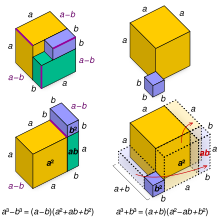|
Sum of two cubes In mathematics, the sum of two cubes is a cubed number added to another cubed number. FactorizationEvery sum of cubes may be factored according to the identity in elementary algebra.[1] Binomial numbers generalize this factorization to higher odd powers. "SOAP" methodThe mnemonic "SOAP", standing for "Same, Opposite, Always Positive", is sometimes used to memorize the correct placement of the addition and subtraction symbols while factorizing cubes.[2] When applying this method to the factorization, "Same" represents the first term with the same sign as the original expression, "Opposite" represents the second term with the opposite sign as the original expression, and "Always Positive" represents the third term and is always positive.
ProofStarting with the expression, and multiplying by a + b[1] distributing a and b over ,[1] and canceling the like terms,[1] Similarly for the difference of cubes, Fermat's last theoremFermat's last theorem in the case of exponent 3 states that the sum of two non-zero integer cubes does not result in a non-zero integer cube. The first recorded proof of the exponent 3 case was given by Euler.[3] Taxicab and Cabtaxi numbersA Taxicab number is the smallest positive number that can be expressed as a sum of two positive integer cubes in n distinct ways. The smallest taxicab number after Ta(1) = 1, is Ta(2) = 1729,[4] expressed as
Ta(3), the smallest taxicab number expressed in 3 different ways, is 87,539,319, expressed as
A Cabtaxi number is the smallest positive number that can be expressed as a sum of two integer cubes in n ways, allowing the cubes to be negative or zero as well as positive. The smallest cabtaxi number after Cabtaxi(1) = 0, is Cabtaxi(2) = 91,[5] expressed as:
Cabtaxi(3), the smallest Cabtaxi number expressed in 3 different ways, is 4104,[6] expressed as
See also
References
Further reading
|















